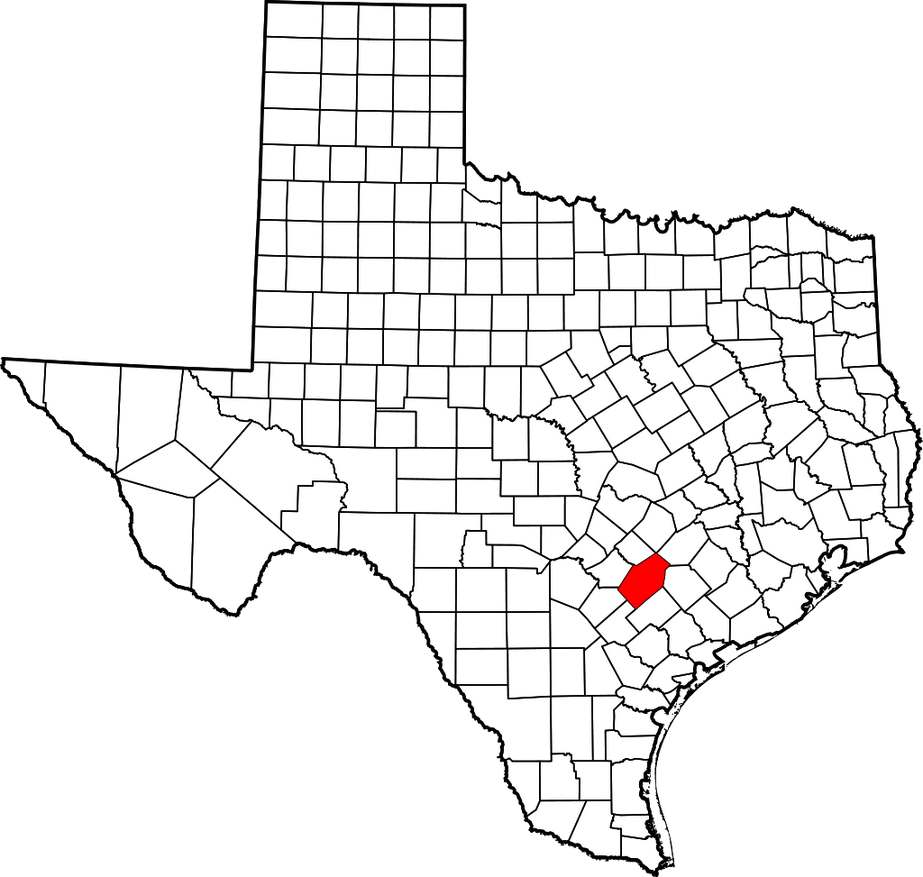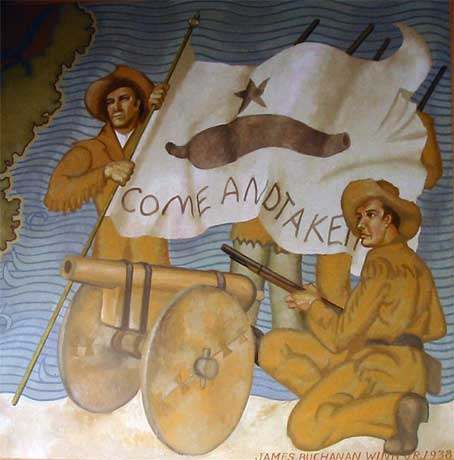The Battle of Gonzales may not be the lengthiest or bloodiest battle in history, but it was significant, marking the beginning of the Texas Revolution. It’s a story where a simple demand to return a cannon ignited a full-scale rebellion. Intrigued? Let’s dive into the fascinating details of this battle:
What is the Battle of Gonzales?
On a cool autumn day in 1835, the small town of Gonzales became the unlikely stage for a pivotal confrontation. The Mexican government wanted their cannon back, but the Texian settlers had other plans. This wasn’t just about a piece of artillery but about standing up to perceived tyranny. The settlers’ defiant response? The iconic flag bearing the words “Come and Take It.” This simple yet powerful message symbolized their fierce desire for freedom and set the stage for the dramatic events that followed.
As we explore the lead-up to this historic clash, the main events of the battle itself, and its lasting repercussions, you’ll see how Gonzales was more than just a simple fight —it was the spark that lit the fire of Texas independence. So, whether you’re a history buff or just curious about how a small town could influence the course of history, you’re in the right place. Let’s get to the heart of why Gonzales is often called the “Lexington of Texas.”
Historical Context Leading Up to the Battle of Gonzales
The road to the Battle of Gonzales was paved with political and social tensions between the Mexican authorities and Texian settlers, deeply rooted in governmental policies that clashed with the settlers’ aspirations and way of life.
In the early 1830s, under President Antonio López de Santa Anna, the Mexican government began enforcing centralist reforms that shifted away from the federalist constitution 1824. These reforms previously granted significant autonomy to Mexican states, including Texas. Many Texian settlers perceived this as a direct threat to their rights and local governance.
Central to the growing discontent were two contentious issues: the ban on slavery and strict immigration controls. 1829 Mexico abolished slavery, but enforcement varied significantly across its territories. In Texas, where the economy was increasingly reliant on slave labor, especially for cotton production, this posed a direct challenge to the settlers’ economic interests.
Moreover, the Law of April 6, 1830, aimed at curtailing immigration from the United States, further fueled the settlers’ grievances. This law restricted further settlement and imposed heavy tariffs on goods imported from the U.S., straining the Texians economically and increasing their sense of alienation.
These policies did not sit well with the Texians, many of whom were recent immigrants from the United States accustomed to a high degree of autonomy. As Mexican oversight tightened and cultural and economic tensions escalated, the stage was set for confrontation. The settlers were not just fighting for their right to own slaves or evade tariffs; they were fighting for preserving their way of life and governance as they saw fit.
By September 1835, when Mexican troops were sent to Gonzales to retrieve a small cannon loaned to the settlers for defense against Native American attacks, the Texians saw this as the last straw. Demanding to return the cannon symbolized a broader struggle against an increasingly oppressive regime.
Through these escalating tensions, the Battle of Gonzales would symbolize a definitive break from Mexico and the beginning of a broader struggle for Texian independence.
Main Events of the Battle of Gonzales
The Battle of Gonzales, often heralded as the “Lexington of Texas,” was a crucial event that set the Texas Revolution into motion.
The Request for the Cannon
In late September 1835, the Mexican government, wary of the rising unrest among Texian settlers, made a strategic decision to reclaim a small cannon that had been previously loaned to the settlers of Gonzales for defense against Native American attacks. The cannon, though modest in size, had become a symbol of defiance among the Texians as tensions escalated.
Colonel Domingo de Ugartechea of the Mexican Army dispatched soldiers to Gonzales to retrieve the weapon, signaling the tightening control of the centralist government over the Texian settlers.
Standoff at the Guadalupe River
As Mexican troops approached Gonzales, they found themselves unexpectedly thwarted by the swollen waters of the Guadalupe River. On the opposite bank, a group of determined Texians, later known as the “Old Eighteen,” fortified their position, effectively blocking the Mexican soldiers from crossing. The ensuing standoff was marked by a tense atmosphere, with both sides preparing for potential conflict. The Texians had removed all boats and ferries, making it impossible for the Mexican troops to cross without a confrontation.
The Battle and Tactical Maneuvers
The initial Mexican attempt to negotiate the return of the cannon failed, as the Texians, fueled by a growing desire for independence, refused to comply. The Texians fortified their position, burying the cannon in a peach orchard to hide it and sending couriers to nearby settlements to rally additional support. As reinforcements swelled the Texian ranks, the Mexican troops, led by Lieutenant Francisco de Castañeda, realized a direct assault was increasingly unfeasible.
On the morning of October 2, 1835, the Texians, now bolstered by additional forces, decided to take the offensive. They dug up the cannon and mounted it on a cart, positioning it strategically. As the Mexican forces attempted to navigate around the river, the Texians executed a series of maneuvers that showcased their resolve and tactical ingenuity.
The Symbolic Firing of the Cannon
The climax of the Battle of Gonzales came when the Texians, under the banner of “Come and Take It,” fired the cannon at the Mexican troops. This defiance was more symbolic than militarily significant but resonated deeply, marking a clear and irreversible step toward revolution. The message was clear: the Texians would not submit quietly to perceived tyranny.
The battle that followed was brief and relatively bloodless, but the implications were profound. The Mexican troops, unable to secure the cannon or quell the escalating rebellion, were forced to retreat. This set the stage for the subsequent struggle for Texan independence.
Aftermath and Significance of the Battle of Gonzales
The Battle of Gonzales, while minor in scale, had profound and far-reaching consequences that catalyzed the Texas Revolution and eventually led to the formation of the Republic of Texas. Here’s how the events unfolded and their significance:
Galvanization of the Texian Resistance
The immediate aftermath of the Battle of Gonzales saw a dramatic surge in morale among the Texian settlers. The successful defiance against Mexican troops emboldened the settlers and served as a rallying cry for those who were previously hesitant to join the cause. News of the skirmish spread rapidly, symbolizing a clear rejection of Mexican authority and inspiring widespread support for the Texian cause.
In the weeks following the battle, volunteer fighters from across Texas converged to join the burgeoning Texian army. This influx of manpower was crucial as it prepared the settlers for subsequent conflicts. The battle effectively transformed a series of isolated grievances into a unified front for independence.
Setting the Stage for the Texas Revolution
The significance of the Battle of Gonzales extended beyond its immediate tactical outcomes. It marked the beginning of open hostilities between the Texian settlers and the Mexican government, setting the stage for a series of engagements that would culminate in the Texas Revolution. The clash at Gonzales demonstrated the settlers’ willingness to use force to defend their rights and liberties, a stance that would characterize the ensuing conflict.
The engagement also had strategic implications. It disrupted Mexican plans to quietly reassert control over the region, forcing Santa Anna’s government to reconsider its approach to the Texian issue. The battle made it clear that the conflict would not be resolved without significant military action, prompting both sides to prepare for a protracted conflict.
Impact on the Formation of the Republic of Texas
The Battle of Gonzales was instrumental in the eventual establishment of the Republic of Texas. As the first military victory for the Texian forces, it boosted the confidence and organizational capacity of the rebels. This early success laid the groundwork for future victories, most notably at San Jacinto, where Santa Anna was captured, effectively securing Texian independence.
Moreover, the battle imbued the Texian fight for independence with a sense of inevitability and legitimacy. It transformed the settlers’ resistance from protests and petitions into a viable military and political campaign. The formation of the Republic of Texas in March 1836 was a direct consequence of the momentum gained from early victories like Gonzales.
Debunking Myths and Misconceptions about the Battle of Gonzales
The Battle of Gonzales, often celebrated as a pivotal moment in Texas history, is shrouded in myths and legends that sometimes overshadow the factual events. Let’s clarify some common misconceptions and highlight the battle’s historical significance.
Myth: The Scale of the Battle
One popular myth about the Battle of Gonzales is its scale. Often depicted as a large-scale military engagement, the reality was much less dramatic. In fact, the battle involved a relatively small number of combatants—only 18 Texians, known as the “Old Eighteen,” initially stood against a similarly modest Mexican detachment. The engagement was brief and not as militarily significant as other confrontations during the Texas Revolution. The myth of a large battle likely stems from the symbolic importance of the event, which magnified its perceived size and impact in popular recountings.
Myth: The Number of Participants
Another common exaggeration relates to the number of participants involved. While reinforcements from surrounding areas did swell the numbers of Texian defenders, the actual combatants during the critical moments of the battle were few. The Mexican forces under Lieutenant Francisco de Castañeda were hesitant to engage aggressively, mindful of their orders to avoid unnecessary conflict, further limiting the scale of the battle.
The Symbolic Significance Over Military Impact
The most significant aspect of the Battle of Gonzales was symbolic rather than military. The refusal to surrender the cannon, emblazoned with the phrase “Come and Take It,” epitomized the Texian spirit of defiance and became a rallying cry for the revolution. The battle’s real importance lies in its role as a catalyst for larger conflicts, marking the start of open hostilities between Texians and the Mexican government.
Conclusion
The Battle of Gonzales is important in Texas history because it sparked the Texas Revolution. It wasn’t a big battle, but it showed the determination of the Texian settlers. They used a simple message, “Come and Take It,” to stand up to Mexican forces, showing their strong desire for freedom. This small fight led to big changes, helping to create the Republic of Texas. The Battle of Gonzales reminds us that even small actions can make a big difference in history.




